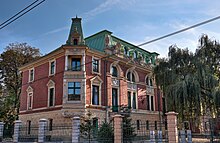Sosnowiec
Sosnowiec[a] is an industrial city county in the Dąbrowa Basin of southern Poland, in the Silesian Voivodeship, which is also part of the Metropolis GZM municipal association.Sosnowiec serves as one of the administrative centres of the geographical and historical area of southern Poland known as the Zagłębie Dąbrowskie (the Dąbrowa Basin).It was a small settlement in the Polish Duchy of Kraków, located in close vicinity of much larger and better-developed villages of Sielce and Zagórze (both are now districts of the city).During the January Uprising, in February 1863, the Battle of Sosnowiec was fought, in which Polish insurgents led by Apolinary Kurowski [pl] defeated the Russians.[8] With effect from 10 June 1902, by the order of Emperor Nicholas II of Russia, Sosnowiec was legally named a city with the area of 19 square kilometres (7 sq mi) and with 60,000 inhabitants.The newly established town consisted of the districts of Sosnowiec, Pogoń, Ostra Górka, Sielec, Kuźnica and Radocha, all of which had been separate villages before.[citation needed] After the 1939 Invasion of Poland, which started World War II, the city was occupied by Nazi Germany and renamed Sosnowitz.[11] Initially under military administration set up as part of the General Government, Sosnowiec was annexed by Germany and incorporated into the Province of Silesia on 20 November 1939.Its Special Economic Zone, established in Sosnowiec thanks to the efforts of local authorities, plays a major role in attracting new businesses into the area.Sosnowiec City Office was awarded the ISO 9001 2001 quality certificate for its management system for providing services for the local community.In 2004 Sosnowiec authorities and designers were awarded the Grand Prix for the rebuilding of the downtown area in a competition for the best public space in the Śląskie Provinces.Other main tourist attractions include:[22][23] Sosnowiec has more than 2,250 ha of green areas occurring as parks, squares, protection zones, lot gardens and forests.











Sosnowiec (disambiguation)Jan KiepuraSielecki CastleSosnowiec CathedralNew Schöen's PalaceCountryPolandVoivodeshipSilesianCountyArkadiusz ChęcińskiDemonym(s)Time zoneArea codeCar platesKatowice Airportcity countyDąbrowa BasinSilesian VoivodeshipMetropolis GZMUpper Silesian Industrial RegionKatowice urban areaconurbationKatowice-Ostrava metropolitan areaYiddishKielce VoivodshipŁódź VoivodshipOpole VoivodshipZagłębie DąbrowskieLesser PolandSilesiaKatowiceKrakówSilesian UplandBrynicaPrzemszaVistulaBiała PrzemszaKatowice VoivodeshipWorld War IIKielce Voivodeshipcity rightsDuchy of KrakówZagórzeKlimontówPolish–Lithuanian CommonwealthKraków VoivodeshipLesser Poland Provinceborder townDuchies of SilesiaBohemian Crownthird partition of PolandKingdom of PrussiaNew SilesiaNapoleonic WarsDuchy of WarsawCongress PolandnamiestniksRussian EmpireGerman EmpireAustria-HungaryThree Emperors' CornertripointJanuary UprisingBattle of SosnowiecNicholas II of RussiaPuławyWarsaw-Vienna Railwayindependent PolandŚrodulaWorld War ISecond Polish RepublicInvasion of PolandoccupiedNazi GermanyEinsatzgruppe zbVmilitary administrationGeneral Governmentannexed by GermanyProvince of SilesiaCelinyStalag VIII-B/344prisoner-of-war campPolish underground resistance movementSosnowiec GhettoAuschwitz concentration campforced labourerskidnapped Polish childrenPotulice concentration campVistula–Oder OffensiveRed ArmyKatowice SteelworksRoman Catholic Diocese of SosnowiecUniversity of SilesiaISO 9001Sielec ParkDębowa GóraCzeladźBędzinDąbrowa GórniczaSławkówMysłowiceJaworznoDietel PalaceSchön PalaceThe Dietel PalaceSchöen PalaceOskar Schöen's PalaceCathedral Basilica of the Assumption of the Blessed Virgin MaryOrthodox Church of the Holy Virgin, Hope, Luby and their mother ZofiaSt. John Evangelical ChurchSt Thomas ChurchRailway Station Sosnowiec GłównycastleDietel ParkŚrodula Parksports complexNatura 2000University of Silesia in KatowiceMedical University of Silesia in KatowiceArena SosnowiecKH Zagłębie SosnowiecZagłębie SosnowiecfootballPolish Cupice hockey



